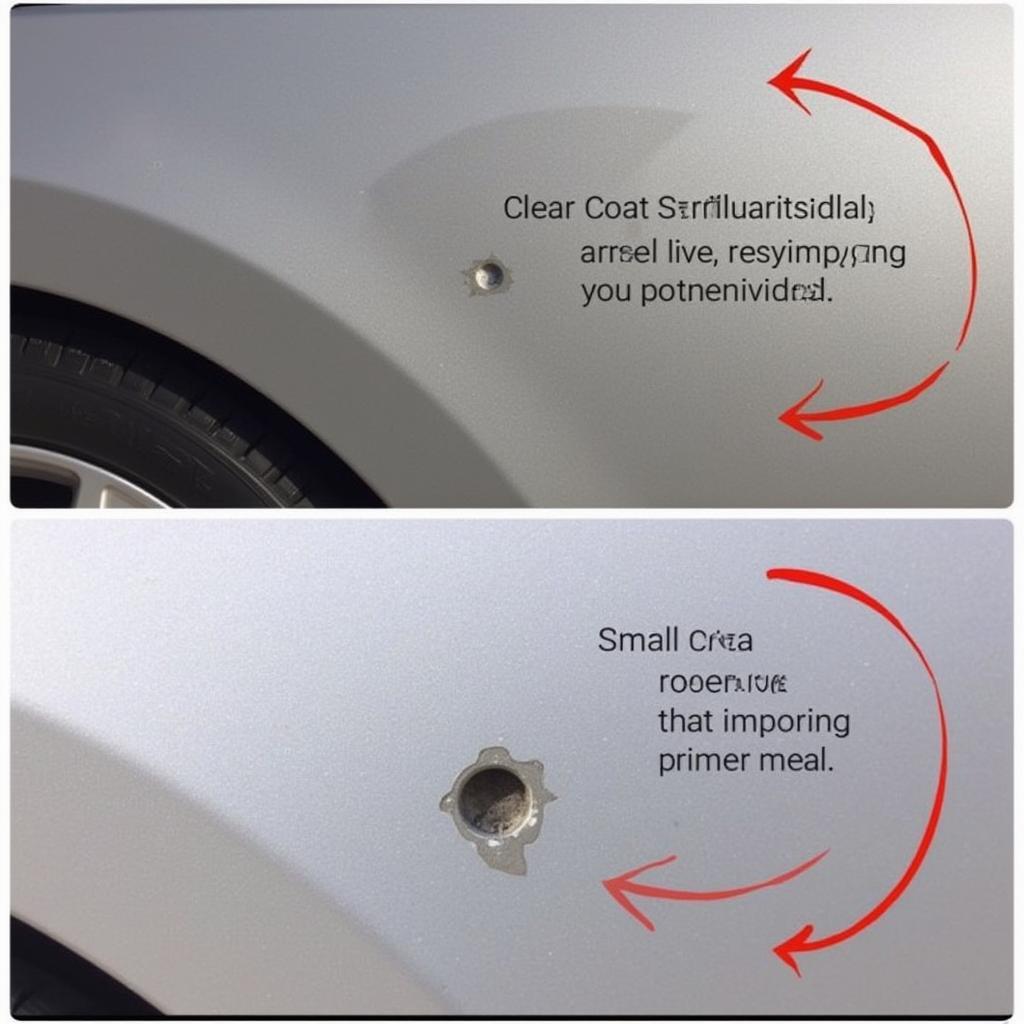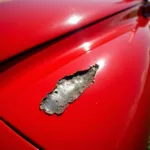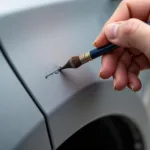Car paint repair is an inevitable part of car ownership. Whether it’s a minor scratch from a rogue shopping cart or a more significant dent from a fender bender, knowing your options for oops car paint repair can save you time and money. This guide will walk you through everything you need to know, from identifying the type of damage to choosing the right repair method and even tackling some DIY fixes.
Understanding Your Car Paint Damage
Before jumping into car paint repair solutions, it’s crucial to understand the extent of the damage. Is it a clear coat scratch, a paint chip, a dent with paint damage, or something more serious? Knowing the type of damage will determine the best course of action. A simple scratch might be buffed out, while a deep dent might require professional bodywork and repainting.
Types of Car Paint Damage
- Clear Coat Scratches: These are superficial scratches that only affect the clear coat, the protective layer on top of your car’s paint. They often appear as light, swirling marks.
- Paint Chips: These are small areas where the paint has chipped away, exposing the primer or even the bare metal underneath. They are more serious than clear coat scratches and require prompt attention to prevent rust.
- Scratches Through the Paint: These scratches go deeper than the clear coat and penetrate the paint layer, exposing the primer. They are more visible and require more extensive repair than clear coat scratches.
- Dents with Paint Damage: These involve both structural damage to the car’s body and damage to the paint. Repairing these often requires professional bodywork to reshape the dented area before repainting.
DIY Car Paint Repair Options
For minor scratches and chips, DIY car paint repair can be a cost-effective solution. Several products are available for oops car paint repair, including:
- Touch-Up Paint: This is a small bottle of paint that matches your car’s color. It’s ideal for filling in small chips and scratches.
- Rubbing Compound: This is an abrasive paste that can remove minor scratches and swirl marks from the clear coat.
- Scratch Remover Kits: These kits typically contain rubbing compound, polishing compound, and applicators.
DIY Car Paint Repair Steps
- Clean the Area: Thoroughly wash and dry the damaged area.
- Apply Touch-Up Paint (if needed): Use a fine-tipped applicator to carefully fill in chips and scratches with touch-up paint.
- Apply Rubbing Compound: Apply a small amount of rubbing compound to the damaged area and buff it in using a microfiber cloth.
- Polish the Area: Use a polishing compound to restore shine and remove any remaining swirl marks.
When to Seek Professional Help
While DIY solutions can address minor oops car paint repair issues, more significant damage requires professional intervention. Deep dents, extensive scratches, and widespread paint damage are best left to experienced auto body technicians. They have the tools and expertise to restore your car’s finish to its pre-accident condition.
Finding a Reputable Car Paint Repair Shop
- Ask for Recommendations: Seek recommendations from friends, family, or your insurance company.
- Read Online Reviews: Check online reviews and ratings for local car paint repair shops.
- Get Multiple Estimates: Obtain estimates from several shops before making a decision.
Preventing Future Car Paint Damage
Prevention is always better than cure. Taking a few precautions can help protect your car’s paint from future damage:
- Regular Washing and Waxing: Regular washing removes dirt and grime that can scratch the paint, while waxing provides a protective layer.
- Park in Covered Areas: Parking in a garage or under a carport protects your car from the elements and reduces the risk of scratches and dents.
- Use Paint Protection Film: This transparent film applied to vulnerable areas like the hood and bumpers can protect against scratches and chips.
Conclusion
Oops car paint repair doesn’t have to be a headache. By understanding the type of damage and exploring the various repair options available, you can restore your car’s finish and protect your investment. Whether you opt for a DIY fix or seek professional help, addressing car paint damage promptly prevents further deterioration and keeps your car looking its best. Remember, addressing car paint repair promptly is key to maintaining your vehicle’s appearance and value.
FAQ
- How much does oops car paint repair cost? The cost varies depending on the extent of the damage and the chosen repair method.
- Can I repair a dented car panel myself? Minor dents can sometimes be repaired with DIY methods, but significant dents require professional attention.
- What is the best way to remove scratches from my car’s clear coat? Rubbing compound and polishing compound can effectively remove minor scratches.
- How do I match my car’s paint color for touch-up paint? You can find your car’s paint code in your owner’s manual or on a sticker inside the driver’s side doorjamb.
- How often should I wax my car? Waxing your car every three to six months provides optimal protection.
- Can I apply paint protection film myself? While DIY kits are available, professional installation is recommended for the best results.
- How can I prevent rock chips on my car’s paint? Maintaining a safe following distance and avoiding driving on gravel roads can help reduce the risk of rock chips.
Common Car Paint Repair Scenarios
- Scenario 1: Minor scratches from tree branches – Solution: Rubbing compound and polishing compound.
- Scenario 2: Deep scratch exposing primer – Solution: Touch-up paint and possibly professional repair.
- Scenario 3: Dent with paint damage – Solution: Professional bodywork and repainting.
Related Articles
- Choosing the Right Car Wax for Your Vehicle
- Understanding Car Paint Protection Options
When you need assistance, please contact WhatsApp: +1(641)206-8880, Email: [email protected]. We have a 24/7 customer support team.



